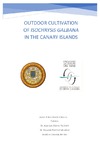Please use this identifier to cite or link to this item:
https://accedacris.ulpgc.es/jspui/handle/10553/74980
| DC Field | Value | Language |
|---|---|---|
| dc.contributor.advisor | Gómez Pinchetti, Juan Luis | es |
| dc.contributor.advisor | Portillo Hahnafeld, Eduardo | es |
| dc.contributor.author | Martín Valencia, Pablo | es |
| dc.date.accessioned | 2020-10-23T14:22:59Z | - |
| dc.date.available | 2020-10-23T14:22:59Z | - |
| dc.date.issued | 2017 | en_US |
| dc.identifier.uri | https://accedacris.ulpgc.es/handle/10553/74980 | - |
| dc.description.abstract | Isochrysis galbana es una microalga marina perteneciente al grupo de las haptophytas. Esta microalga tiene una gran cantidad usos actuales y potenciales como la producción de fucoxantina o el alimento de larvas en acuicultura. Sin embargo, la dificultad de su cultivo outdoor no permite su producción en grandes cantidades. En este experimento se pretende conseguir el mejor método de escalado para su cultivo outdoor en las condiciones ambientales del archipiélago canario. Para ello, se compararon dos métodos de escalado diferentes desde el nivel de botellas en la cámara de cultivo hasta el raceway de 10000 L. Solo uno de los métodos (método II) funcionó hasta el final del proceso y se pudo cosechar, obteniéndose una biomasa de 580 g de PS. Además, se pudo observar que los 4 factores que más influyen en su crecimiento fueron la salinidad, el pH, la intensidad lumínica y los problemas de contaminación. | en_US |
| dc.description.abstract | Isochrysis galbana is a marine microalga that belongs to the group of haptophytes. This microalga has many current and potential uses such as the production of fucoxanthin and the feed of larvae in aquaculture. However, the outdoor cultivation is still complicated and it does not allow to produce large amounts of it. Through this experiment, it is intended to obtain the best method of scale up for its outdoor cultivation in the environmental conditions of the Canary Islands. In order to achieve this, two different scaling up methods were compared from the bottle level in the culture chamber to the 10000 L raceway. Only one method (method II) succeeded and reached the end of the process. Harvest was possible and 580 g of biomass DW was obtained. Furthermore, it was observed that the 4 factors that influenced the most in the growth of the alga were salinity, pH, light intensity and contamination problems. | en_US |
| dc.language | eng | en_US |
| dc.subject | 241707 Algología (ficología) | en_US |
| dc.subject.other | Isochrysis galbana | es |
| dc.title | Outdoor cultivation of "Isochrysis galbana" in the Canary Islands | es |
| dc.type | info:eu-repo/semantics/bachelorThesis | en_US |
| dc.type | BachelorThesis | en_US |
| dc.contributor.departamento | Departamento de Biología | es |
| dc.contributor.facultad | Facultad de Ciencias del Mar | en_US |
| dc.investigacion | Ciencias | en_US |
| dc.type2 | Trabajo final de grado | en_US |
| dc.utils.revision | Sí | en_US |
| dc.identifier.matricula | TFT-42294 | es |
| dc.identifier.ulpgc | Sí | en_US |
| dc.contributor.buulpgc | BU-BAS | es |
| dc.contributor.titulacion | Grado en Ciencias del Mar | es |
| item.grantfulltext | restricted | - |
| item.fulltext | Con texto completo | - |
| crisitem.advisor.dept | GIR IOCAG: Oceanografía Biológica y Algología Aplicada | - |
| crisitem.advisor.dept | IU de Oceanografía y Cambio Global | - |
| crisitem.advisor.dept | Departamento de Biología | - |
| Appears in Collections: | Trabajo final de grado Restringido ULPGC | |
Page view(s)
141
checked on Oct 31, 2024
Download(s)
35
checked on Oct 31, 2024
Google ScholarTM
Check
Share
Export metadata
Items in accedaCRIS are protected by copyright, with all rights reserved, unless otherwise indicated.
